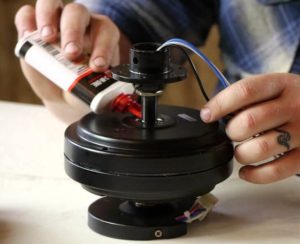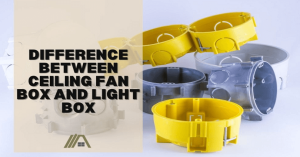I often pay attention to the importance of being in the same room as a ceiling fan for it to serve its purpose, there is an additional factor to consider.
Ceiling fans can play a significant role in the air circulation system of your home, depending on their location. In this role, they work in a slightly different manner compared to their role in cooling a room, but they can still bring about considerable benefits and prove highly effective.
During the winter season, set your ceiling fan to rotate counterclockwise, often known as the “summer mode.” This direction of rotation helps in pulling down the hot air that moves around the upper floors, effectively distributing it to the lower floors. In the summer months, switch the ceiling fan to rotate clockwise, known as the “winter mode.” This helps the upward movement of cold air from the lower floors, helping it in its circulation throughout the upper floors.
Purpose of a Ceiling Fan at the Top of Stairs
The main task of a ceiling fan is to provide a cooling effect by circulating air and creating a breeze that cools the occupants of a room. Therefore, I suggest installing fans in spaces where you spend enough time to fully benefit from them.
Stairwells, however, are the areas where people do not typically spend too much time. So, placing a fan at the top of the stairs may not offer the same direct cooling benefits as in rooms.
Nonetheless, this does not mean that installing a ceiling fan at the top of the stairs is without any benefits. While it may not serve its main function in this location, the fan can still contribute to improving air circulation throughout a multi-story house.
Stairway Ceiling Fan Direction in Winter
During the winter season, your objective is to ensure that warm air is evenly distributed throughout the house to avoid it accumulating in the attic where it serves as of no use. To maximize the effectiveness of a ceiling fan installed in your stairway during winter, it is recommended to set it to run counterclockwise, which is typically the summer mode.
In the summer mode, the fan’s blades move in a manner where the highest points of the blade pitch lead the way. This configuration allows them to pull air from above, typically from the upper floor, and push it down through the blades toward the lower floor. By doing so, the unit helps in redistributing heat.
Considerations
There are a few factors to consider that will help the stairway ceiling fan to be more effective:
- You should use the fan on a low-speed setting that will prevent creating a strong draft.
- The fan doesn’t need to generate a strong breeze to circulate air effectively throughout the house. In fact, during the winter season, you may find it more comfortable to have minimal airflow in the stairway area and to prevent the wind chill effect.
- When it comes to choosing a stairway fan, a standard (downrod) mount fan is the recommended option. Compared to flush mount and hugger fans, downrod models perform better in this space. They have more clearance between the blades and the ceiling. The increased space allows for a greater volume of air to be drawn downwards, resulting in improved airflow.
- This method of air circulation is every effective in staircases that are open and lead to rooms or open landings. In enclosed stairways that lead to hallways, the airflow may be impeded, resulting in less effective circulation. Therefore, the ample space around the fan is beneficial for optimal airflow.
- You should turn off the fan before going to bed. This allows the air to naturally concentrate on the upper floors of the house, where bedrooms are typically located.
Stairway Ceiling Fan Direction in Summer
During the summer season, it is essential to evenly distribute cold air throughout the entire house. Cold air tends to accumulate on the lower floors, such as the basement, which means it needs to be circulated upwards. To accomplish this, simply set your fan to rotate in a clockwise direction, also known as winter mode.
In winter mode, the blades rotate in a clockwise direction, causing the lower points of the blade pitch to lead. As a result, air is pulled up from below the fan, specifically from the lower levels of the house, and pushed out above the fan towards the upper floor.
If you have a fan installed at the top of your basement stairs, this airflow direction can help prevent the descent of cold air, especially if you are using air conditioning in the rooms located above it.
Considerations
When using a fan in the summer, there are a few considerations to keep in mind:
- Opt for a standard mount fan rather than flush or hugger mounts. The additional space provided by the downrod enables more efficient distribution of the updraft. Instead of air merely moving along the ceiling, it can be effectively circulated throughout the room.
- As I stated earlier, the effectiveness of the fan is boosted in open staircases leading to open areas compared to enclosed staircases leading to hallways. The availability of more space allows the fan to generate better airflow, resulting in improved circulation and comfort.
- When using the fan in this manner, it’s important to note that heat will be displaced downward, which causes a slight increase in temperature in the lower areas of the house. However, the difference is typically minimal and should not have a noticeable impact on your comfort.
- To facilitate better circulation of the cool air, you can keep the basement door open. Additionally, leaving the fan running during the night can be beneficial as it ensures the continued redistribution of the cool air while you sleep.
Are Stairway Fans Effective?
Installing a ceiling fan in a stairway can greatly improve the efficiency of your HVAC system by promoting better air circulation throughout your home. This, in exchange, can lead to more balanced temperatures and lower your electricity and fuel costs.
During the winter, it’s common for hot air to rise and accumulate in the upper areas of the house, leaving the downstairs areas colder, where the thermostat is typically located. This temperature distribution can cause your system to work harder in order to maintain a consistent temperature throughout the house. Similarly, in the summer, the cool air from the AC may tend to collect in the lower areas of the house while you remain warmer in the upper areas.
By using a fan in the stairway, you can help mix and balance out the different air temperatures in your home. This ensures that your thermostat is responding to the average temperature rather than the extremes, resulting in improved comfort and energy efficiency.


